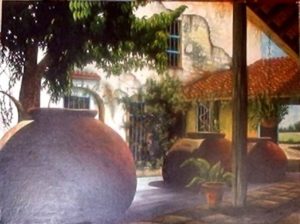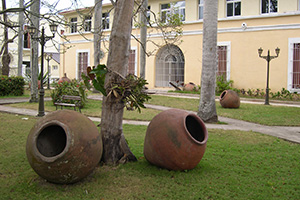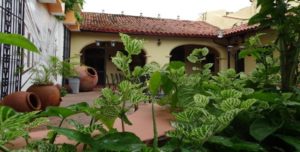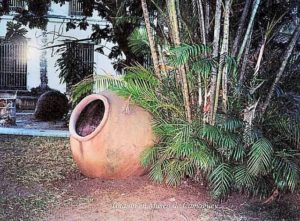 ORIGEN DE LOS “TINAJONES” DE CAMAGUEY, CUBA. FOTOS.
ORIGEN DE LOS “TINAJONES” DE CAMAGUEY, CUBA. FOTOS.
Santa María del Puerto del Príncipe fue uno de los siete asentamientos (villas) originales fundados en Cuba por los españoles en 1514. En el sitio de una aldea taína llamada Camagüey.
El símbolo de la ciudad de Camagüey es la vasija de barro o tinajón, utilizada para capturar agua de lluvia y mantenerla fresca.
La Villa de Santa María del Puerto del Príncipe, una vez establecida definitivamente en el territorio actual el 6 de enero de 1528, tuvo una seria dificultad con el agua, lo que obligó a la búsqueda de una solución.
La Villa estaba rodeada de abundantes tierras arcillosas, barro de excelente calidad, que constituyeron la materia prima para los primeros recipientes destinados a almacenar el preciado líquido.
ORIGENES DEL TINAJON CAMAGUEYANO.
Se dice que el origen del tinajón es andaluz, y que allá se utilizaba para conservar los aceites, especialmente el de olivo, de ahí que los conquistadores trajeran el modelo para nuestro Camagüey.
Los tinajones eran situados en los patios de las casas; al comenzar las lluvias primaverales se esperaba que el primer aguacero limpiara los tejados y luego comenzaban a llenarse mediante curiosos sistemas de canales, primero de madera y después de hojalata o latón.
Una vez llenos, algunas familias protegían la cresta con telas de mosquitero y tapas del mismo material que la canal, para evitar que los mosquitos depositaran sus larvas en el agua, la que utilizaban preferiblemente para beber y cocinar.
La fabricación de tinajones camagüeyanos comienza a principios del siglo XVII (barro cocido); numerosos artesanos convirtieron su manufactura en un esmerado trabajo de artesanía, con detalles decorativos y siempre con cifrados personales y la fecha de fabricación.
A través del tiempo la preciada pieza sufrió transformaciones en la cresta, panza y su base, de tal manera que en muchos casos, al no existir elementos visibles que permitan determinar su antigüedad, las características morfológicas brindan un valioso apoyo para su estudio.
A mediados del siglo XIX se consideró exagerada la existencia de los tinajones en las casas de la ciudad, por lo que se detuvo su fabricación. En diciembre de 1900 las autoridades norteamericanas que ocupaban nuestra Isla realizaron un inventario de los tinajones existentes en la ciudad de Puerto Príncipe, el que arrojó la cifra de 16 mil 483.
Esta bella pieza llegó a convertirse en el símbolo que, desde hace décadas, representa a nuestra ciudad.
 ORIGIN OF THE “TINAJONES” OF CAMAGUEY, CUBA. PHOTOS.
ORIGIN OF THE “TINAJONES” OF CAMAGUEY, CUBA. PHOTOS.
Santa María del Puerto del Príncipe was one of the seven original settlements (villas) founded in Cuba by the Spanish in 1514. On the site of a Taíno village called Camagüey.
The symbol of the city of Camagüey is the earthenware vessel or tinajón, used to capture rainwater and keep it fresh.
The Villa de Santa María del Puerto del Príncipe, once definitively established in the current territory on January 6, 1528, had a serious difficulty with the water, which forced the search for a solution.
The Villa was surrounded by abundant clay lands, the mud of excellent quality, which constituted the raw material for the first containers destined to store the precious liquid.
ORIGINS OF THE “TINAJON CAMAGUEYANO”.
It is said that the origin of the tinajón is Andalusian and that it was used there to conserve oils, especially olive oil, hence the conquerors brought the model for our Camaguey.
The tinajones were located in the courtyards of the houses; At the beginning of the spring rains, the first downpour was expected to clean the roofs and then they began to be filled by curious systems of channels, first of wood and then of tin or brass.
Once filled, some families protected the crest with mosquito netting and covers of the same material as the canal, to prevent mosquitoes depositing their larvae in the water, which they used preferably for drinking and cooking.
The manufacture of Camaguean tinajones begins at the beginning of the 17th century (cooked clay); numerous artisans turned their manufacturing into a careful work of crafts, with decorative details and always with personal ciphers and the date of manufacture.
Over time the precious piece underwent transformations in the crest, belly and its base, in such a way that in many cases, since there are no visible elements that allow determining its age, the morphological characteristics provide valuable support for its study.
In the mid-nineteenth century, the existence of the tinajones in the houses of the city was considered exaggerated, the reason why its manufacture was stopped. In December of 1900, the North American authorities that occupied our Island made an inventory of the tinajones existing in the city of Port-au-Prince, which threw the figure of 16 thousand 483.
This beautiful piece became the symbol that, for decades, represents our city.
Agencies/ Wiki/ RHC/ María Candela/ Internet Photos/ Arnoldo Varona/ www.TheCubanHistory.com
THE CUBAN HISTORY, HOLLYWOOD.









